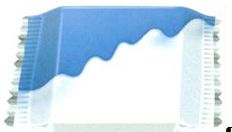
August Storck KG ("AS") sought to register the above figurative mark for: "Confectionery, chocolate, chocolate products, pastries, ice-creams, preparations for making the aforementioned products, included in this class." in class 30.
This sign was rejected for lack of distinctive character. The decision was upheld by the Board of Appeal, and the applicant appealed to the General Court, on the following grounds.
First, it stated that the EUIPO had wrongly applied the distinctiveness criteria relating to three dimensional marks and had wrongly assumed that the sign in question was a three-dimensional mark. The General Court reiterated the position that average consumers do not habitually make assumptions about the origin of goods based on their shape or that of their packaging in the absence of word or graphic elements. Therefore, it could prove to be harder to establish the distinctiveness of such a three-dimensional mark compared to a word or a figurative mark. It also underlined that the case law on three-dimensional marks also applied to two-dimensional representations of goods, referring for example to an earlier case involving AS (Storck v OHIM C-25/05 P).
The appellant also argued that the EUIPO did not take into account the overall impression given by the mark, and only examined the individual features separately. At the same time, the Office had allegedly failed to give due recognition to the contribution of those features towards the distinctiveness of the mark. The Court held that the assessment of individual elements was not incompatible with a global assessment of a mark. The Court also agreed with the Board of Appeal's assessment that the individual features, including the square shape, the colours used (light blue, white and grey) and the pattern in which they were applied, were commonplace and did not depart significantly from the standards of the category.
Thirdly, the applicant complained that the Board of Appeal did not take into account surveys carried out in Germany and in Austria in 2014, all of which allegedly fulfilled all the requirements of the EUIPO guidelines. The Court held that the German evidence did not prove that the mark was inherently distinctive, since most of the respondents were already familiar with it, nor was it wide-ranging enough to show distinctiveness for EU consumers as a whole, as it was limited to German consumers. As the survey in Austria had only been first submitted before the General Court, it was inadmissible: it should have been provided before the Board of Appeal as the General Court's function was not to determine points of fact but to decide whether the law had been applied correctly.
Fourthly, AS argued that the level of attention of the average EU consumer was high in this case, because the goods were purchased and consumed for pleasure, and they were likely to have an impact on the health of the user. The court disagreed, the products were inexpensive everyday consumer goods bought without a long period of reflection. Additionally, the health risks of those everyday consumer goods were not established.
Fifthly, the applicant submitted that the mark's existing national registrations in 17 Member States, while not binding on the EU IPO, was nonetheless a strong indication of its distinctive character. The General Court underlined that the EU trade mark regime was "an autonomous system with its own set of rules and with objectives peculiar to it and applie[d] independently of any national systems". Therefore, national registrations were one factor that could be taken under consideration but did not have decisive weight. The registrability of a sign as an EU trade mark therefore had to be assessed only by reference to the relevant EU rules, and the court accordingly dismissed this point.
The applicant stated that the Board of Appeal had recently registered marks similar to the mark in question here and without a higher level of distinctiveness. Although the Board was not bound by previous decisions, AS stated that those examples nonetheless demonstrated that the Board of Appeal had applied a different standard in assessing the level of distinctiveness required in the present case. The Court rejected that argument, reiterating the position that the legality of the decision of the Board of Appeal was not to be assessed on the basis of previous EUIPO decisions.
The appeal was dismissed.
This case provides a useful review of the position on the distinctiveness of three dimensional marks. It is also interesting to note that several of the points raised had already been addressed in previous matters involving the same applicant, raising the question whether AS had hoped that the position of the EUIPO had changed since those earlier decisions.
Case T-806/14
The content of this article is intended to provide a general guide to the subject matter. Specialist advice should be sought about your specific circumstances.
